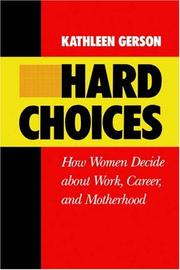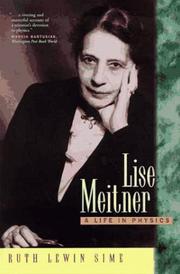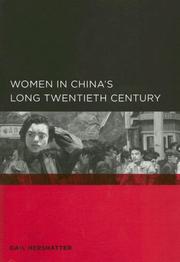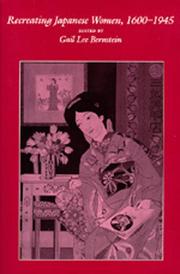| Listing 1 - 6 of 6 |
Sort by
|
Book
ISBN: 0520970675 Year: 2020 Publisher: Berkeley, CA : University of California Press,
Abstract | Keywords | Export | Availability | Bookmark
 Loading...
Loading...Choose an application
- Reference Manager
- EndNote
- RefWorks (Direct export to RefWorks)
In Crunch Time, Aliya Hamid Rao gets up close and personal with college-educated, unemployed men, women, and spouses to explain how comparable men and women have starkly different experiences of unemployment. Traditionally gendered understandings of work—that it’s a requirement for men and optional for women—loom large in this process, even for marriages that had been not organized in gender-traditional ways. These beliefs serve to make men’s unemployment an urgent problem, while women’s unemployment—cocooned within a narrative of staying at home—is almost a non-issue. Crunch Time reveals the minutiae of how gendered norms and behaviors are actively maintained by spouses at a time when they could be dismantled, and how gender is central to the ways couples react to and make sense of unemployment.
Unemployed --- Sex differences. --- chores. --- college education. --- downsizing. --- dual income family. --- economics. --- employment. --- gender norms. --- gender. --- gendered work. --- household labor. --- housework. --- job candidate. --- job search. --- layoffs. --- marriage. --- mens unemployment. --- mens work. --- nonfiction. --- unemployment. --- women in the workforce. --- womens studies. --- womens unemployment. --- womens work. --- working women.
Book
ISBN: 1283277379 9786613277374 0520947819 9780520947818 9780520222328 0520222326 9780520266971 0520266978 9781283277372 Year: 2010 Publisher: Berkeley University of California Press
Abstract | Keywords | Export | Availability | Bookmark
 Loading...
Loading...Choose an application
- Reference Manager
- EndNote
- RefWorks (Direct export to RefWorks)
Shadow Mothers shines new light on an aspect of contemporary motherhood often hidden from view: the need for paid childcare by women returning to the workforce, and the complex bonds mothers forge with the "shadow mothers" they hire. Cameron Lynne Macdonald illuminates both sides of an unequal and complicated relationship. Based on in-depth interviews with professional women and childcare providers- immigrant and American-born nannies as well as European au pairs-Shadow Mothers locates the roots of individual skirmishes between mothers and their childcare providers in broader cultural and social tensions. Macdonald argues that these conflicts arise from unrealistic ideals about mothering and inflexible career paths and work schedules, as well as from the devaluation of paid care work.
Au pairs. --- Child care. --- Child care services. --- Motherhood. --- Nannies. --- Child care --- Au pairs --- Nannies --- Child care services --- Motherhood --- american nannies. --- attachment. --- au pairs. --- career paths. --- caregivers. --- childcare providers. --- childrearing. --- complex bonds. --- conflicts. --- contemporary motherhood. --- cultural perspective. --- cultural social. --- europe. --- gender. --- hired mothers. --- immigrant caregivers. --- maternity. --- micropolitics. --- modern issues. --- motherhood. --- mothering. --- nannies. --- nonfiction. --- paid care. --- paid childcare. --- parenthood. --- parenting. --- professional women. --- relationships. --- social tensions. --- western world. --- women in the workforce. --- work schedules.

ISBN: 1282355287 9786612355288 0520908139 9780520908130 9780520051744 0520051742 0520051742 0520057457 9780520057456 9781282355286 Year: 1986 Publisher: Berkeley University of California Press
Abstract | Keywords | Export | Availability | Bookmark
 Loading...
Loading...Choose an application
- Reference Manager
- EndNote
- RefWorks (Direct export to RefWorks)
How do women choose between work and family commitments? And what are the causes, limits, and consequences of the "subtle revolution" in women's choices over the 1960's and 1970's? To answer these questions, Kathleen Gerson analyzes the experiences of a carefully selected group of middle-class and working-class women who were young adults in the 1970's. Their informative life histories reveal the emerging social forces in American society that have led today's women to face several difficult choices.
Women --- Mothers --- Family size --- Social conditions. --- Employment --- History. --- Psychology. --- business. --- childcare. --- childfree. --- childless women. --- economics. --- family commitments. --- family. --- feminism. --- gender roles. --- gender studies. --- gender. --- having it all. --- household labor. --- labor industrial relations. --- labor. --- marriage. --- maternity leave. --- maternity. --- motherhood. --- nonfiction. --- parenting. --- political science. --- sex roles. --- social issues. --- social justice. --- sociology. --- women in the workforce. --- women. --- womens issues. --- womens rights. --- womens studies. --- womens work. --- work and family. --- work life balance. --- working moms. --- working women.

ISBN: 0585055246 0520918991 9786613622723 1280592893 9780520918993 9780585055244 0520089065 0520208609 9780520089068 9781280592898 Year: 1996 Volume: 13 Publisher: Berkeley University of California Press
Abstract | Keywords | Export | Availability | Bookmark
 Loading...
Loading...Choose an application
- Reference Manager
- EndNote
- RefWorks (Direct export to RefWorks)
Lise Meitner (1878-1968) was a pioneer of nuclear physics and co-discoverer, with Otto Hahn and Fritz Strassmann, of nuclear fission. Braving the sexism of the scientific world, she joined the prestigious Kaiser Wilhelm Institute for Chemistry and became a prominent member of the international physics community. Of Jewish origin, Meitner fled Nazi Germany for Stockholm in 1938 and later moved to Cambridge, England. Her career was shattered when she fled Germany, and her scientific reputation was damaged when Hahn took full credit-and the 1944 Nobel Prize-for the work they had done together on nuclear fission. Ruth Sime's absorbing book is the definitive biography of Lise Meitner, the story of a brilliant woman whose extraordinary life illustrates not only the dramatic scientific progress but also the injustice and destruction that have marked the twentieth century.
Women physicists --- Physicists --- Women in physics --- Women physical scientists --- Meitner, Lise, --- Meitner, Lise --- Austria --- Biography --- Meitner, Lise, - 1878-1968. --- Women physicists - Austria - Biography. --- Physics --- Nuclear physics --- Physiciennes --- Physique --- Physique nucléaire --- History --- History. --- Research. --- Histoire --- Recherche --- 20th century. --- biographical. --- career. --- chemistry. --- concentration camp. --- female scientist. --- feminism. --- feminist. --- injustice. --- intellectual property. --- jewish heritage. --- jewish women. --- judaism. --- nazi germany. --- nobel prize. --- nuclear fission. --- nuclear physics. --- refugee. --- role model. --- scientific. --- sexism. --- sexist. --- strong women. --- true story. --- women in history. --- women in stem. --- women in the workforce. --- world history. --- Physique nucléaire --- Research

ISBN: 1281385441 9786611385446 0520916123 9780520916128 9781281385444 0520098560 9780520098565 Year: 2007 Publisher: Berkeley Global, Area, and International Archive :University of California Press
Abstract | Keywords | Export | Availability | Bookmark
 Loading...
Loading...Choose an application
- Reference Manager
- EndNote
- RefWorks (Direct export to RefWorks)
This indispensable guide for students of both Chinese and women's history synthesizes recent research on women in twentieth-century China. Written by a leading historian of China, it surveys more than 650 scholarly works, discussing Chinese women in the context of marriage, family, sexuality, labor, and national modernity. In the process, Hershatter offers keen analytic insights and judgments about the works themselves and the evolution of related academic fields. The result is both a practical bibliographic tool and a thoughtful reflection on how we approach the past.
Feminism --- Women and communism --- Sex role --- Women --- Human females --- Wimmin --- Woman --- Womon --- Womyn --- Females --- Human beings --- Femininity --- Communism and women --- Communism --- Gender role --- Sex (Psychology) --- Sex differences (Psychology) --- Social role --- Gender expression --- Sexism --- Employment --- Social conditions --- S11/0710 --- S11/0730 --- China: Social sciences--Women: general and before 1949 --- China: Social sciences--Women: since 1949 --- Gender roles --- Gendered role --- Gendered roles --- Role, Gender --- Role, Gendered --- Role, Sex --- Roles, Gender --- Roles, Gendered --- Roles, Sex --- Sex roles --- asian women. --- china. --- chinese history. --- chinese literature. --- chinese women. --- communism. --- communist. --- cultural revolution. --- domesticity. --- employment. --- factory workers. --- factory. --- family. --- female infanticide. --- femininity. --- feminism. --- gender roles. --- gender studies. --- gender. --- gendered labor. --- historiography. --- history. --- household labor. --- labor. --- marriage. --- nonfiction. --- peoples republic. --- republic. --- rural women. --- sex roles. --- sexuality. --- urban women. --- women and labor. --- women in the workforce. --- womens history. --- womens studies.

ISBN: 0520910184 1282355708 9786612355707 0585104905 9780520910188 9780585104904 0520070151 9780520070158 0520070178 9780520070172 9781282355705 Year: 1991 Publisher: Berkeley
Abstract | Keywords | Export | Availability | Bookmark
 Loading...
Loading...Choose an application
- Reference Manager
- EndNote
- RefWorks (Direct export to RefWorks)
In thirteen wide-ranging essays, scholars and students of Asian and women's studies will find a vivid exploration of how female roles and feminine identity have evolved over 350 years, from the Tokugawa era to the end of World War II. Starting from the premise that gender is not a biological given, but is socially constructed and culturally transmitted, the authors describe the forces of change in the construction of female gender and explore the gap between the ideal of womanhood and the reality of Japanese women's lives. Most of all, the contributors speak to the diversity that has characterized women's experience in Japan. This is an imaginative, pioneering work, offering an interdisciplinary approach that will encourage a reconsideration of the paradigms of women's history, hitherto rooted in the Western experience.
Women --- Feminism --- Employment --- History. --- #SBIB:316.346H20 --- #SBIB:39A11 --- #SBIB:39A75 --- #SBIB:95G --- J4176.80 --- J4353 --- Human females --- Wimmin --- Woman --- Womon --- Womyn --- Females --- Human beings --- Femininity --- History --- Employment&delete& --- Positie van de vrouw in de samenleving: algemeen --- Antropologie : socio-politieke structuren en relaties --- Etnografie: Azië --- Geschiedenis van Azië (inclusief Arabische wereld, Nabije Oosten) --- Japan: Sociology and anthropology -- gender roles, women, feminism -- history --- Japan: Economy and industry -- labor and employment -- women --- Femmes --- Féminisme --- Histoire --- Travail --- Japan --- Féminisme --- Japon --- agriculture. --- artisan. --- bakufu. --- class. --- division of labor. --- domesticity. --- femininity. --- feminism. --- gender hierarchy. --- gender roles. --- gender studies. --- gender. --- gendered labor. --- handicrafts. --- household chores. --- household labor. --- japan. --- japanese women. --- meiji restoration. --- merchants. --- misogyny. --- onnagata. --- onnarashisa. --- otokorashisa. --- patriarchy. --- peasants. --- post war. --- preindustrial society. --- samurai. --- sexuality. --- shingaku. --- status. --- tokugawa. --- wealth. --- womanhood. --- women and labor. --- women in history. --- women in the workforce. --- womens studies. --- womens work. --- working women.
| Listing 1 - 6 of 6 |
Sort by
|

 Search
Search Feedback
Feedback About UniCat
About UniCat  Help
Help News
News